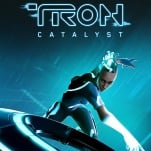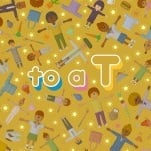Blippo+ Makes Art Out of Channel Surfing

Apologies in advance: I’m going to have to get nostalgic here. There’s no way for somebody of my age to talk about Blippo+ without talking about the outdated form of media consumption that it recreates. Thanks for humoring an old man.
TV used to be glorious—not necessarily the shows themselves, but the experience of watching them. Especially once cable came around, and the old set-up of three networks, a couple rerun-filled UHF stations, and PBS suddenly blossomed into as many as three dozen channels, and you could now spend literally hours just flipping between them all without really committing to watching any of the actual programs for more than a few minutes at a time. It was passive and yet now active in a way watching TV hadn’t really been before, and also full of mystery—before on-screen info panels became standard at some point in the ‘90s, you could watch a whole show, or entire movie even, without ever learning what it was. Channels might go off the air for the night, Nickelodeon would give its airtime over to A&E and, later, Nick @ Nite each evening, but you were guaranteed you’d always find something to stare at, even if it wasn’t anything that would keep your attention longer than a few minutes.
For better and worse, nobody tapped into that sense of mystery, of anticipation and discovery and (inevitably) disappointment, better than MTV. For most of its first decade MTV just played a constant stream of videos, three minute clips that would be over shortly after you became bored with them, all with the semi-unpredictability of a radio station. (Like, you knew you’d be seeing that Michael Jackson or Madonna video at some point, several times a day, but you didn’t know exactly when.) The most interesting thing about early MTV wasn’t the music, though; it was the station IDs MTV played throughout the day. The network would hire legitimately cool and talented animators and experimental filmmakers to make their in-house ads, and they were almost always more artistically adventurous than the actual music videos. And once you got old enough to stay up late, you could catch shows like Liquid Television, which aired experimental animation acquired from film festivals, and 120 Minutes, a two-hour repository for videos from “cutting edge” European bands or independent labels that would never crack regular rotation, and which predated the early ‘90s mainstream popularity of “alternative” music by several years. Between its late night programming and those house ads, the otherwise severely restrictive and tightly playlisted MTV let just enough genuine freak shit onto the air to hip a generation’s worth of kids. (Let’s also tip the hat to basic cable fellow travelers like the USA Network’s Night Flight and TBS’s Night Tracks.)
Years later, just in time for 9/11, Turner gave Cartoon Network’s nighttime hours over to Adult Swim, giving this kind of art-damaged comedy a name brand, and also connecting it forever with the old basic cable practice of splitting the day’s broadcast hours across different subchannels.
The channel-changing freedom of cable made watching TV a favorite pastime of bored teens throughout America in the ‘80s and ‘90s, and the art-friendly short attention span theater of music video helped turn techniques from experimental cinema into mainstream entertainment. And it helps to know this to fully understand Blippo+—the weird art project from YACHT, Telefantasy Studios, Dustin Mierau and Noble Robot that brings together a sprawling consortium of artists, musicians, comedians, and writers, and that made waves on the PlayDate earlier this Spring and has now arrived on the Switch and PC.
Blippo+’s structure explicitly recreates the sensation of changing channels during the early days of basic cable, before channels numbered in the hundreds and became impossible to keep track of. A channel guide acts as its spine, listing every “program” that’s running and what’s coming up next on its dozen or so channels, with each one having a rotation of a handful of short shows. Content is unlocked via “data packettes” that open up after you watch enough of one packette’s programming, and each packette is roughly analogous to a new day’s worth of shows, with new episodes of a channel’s programs streaming in the same order every day.
This isn’t Earthly TV, though. It’s all broadcast from a planet called The Blip—an alien world that feels a lot like ours, complete with English as its primary language, but with occasional differences in slang, the ability to interview the long-dead via “consciousness particles,” and broadcast technology that seems stuck in the late 1980s. At the start of the first packette The Blip’s news and talk shows are all focused on an unusual scientific discovery of another planet on the opposite end of a “bend” in spacetime; they can’t communicate directly with this planet, but they can aim their broadcast airwaves in its direction—and yep, that planet is us, and that’s how we’re watching Blippo+.
-

-

-

-

-

-

-

-

-

-

-

-

-

-

-

-

-

-

-

-

-

-

-

-

-

-

-

-

-

-

-

-

-

-

-

-

-

-

-

-








































